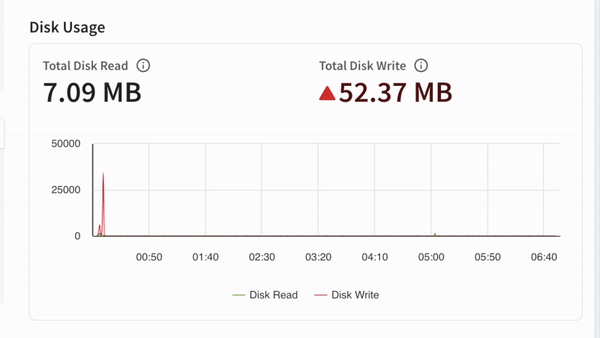iOS Disk Usage
Detect, troubleshoot, and eliminate excessive iOS Disk usage metric
The Disk Usage metric measures the amount of data the app reads and writes (in MB) to the device’s disk during a session. It also shows the total disk reads and total disk writes by the app during the session.
In the app performance report, go to the Disk Usage section to view the disk reads/writes by the app during a session. In the graph, the axes represent the following:
- X-axis: Depicts the time (in seconds) elapsed since the start of the session. 0 on the X-axis represents the start of the profiling session.
- Y-axis: Depicts the amount of data written or read by the app to the disk at a particular time since the session started.
Example
In the following example, you can see that the total disk reads by the app is 7.09 MB and the total disk writes by the app is 52.37 MB. The graph shows that the disk reads peaked at 6.163s. You can check what action caused this peak and decide whether it can be optimized.
To identify the actions or workflows that cause excessive disk usage, you can play the session video. Alongside the video, a bar moves on the graph to help you identify the actions or workflows of your interest. To view disk reads or disk writes individually, use the legends given on the graph.

Impact on user experience
Excessive disk writes can degrade app performance, cause disk write exceptions, and increase wear on device storage. To improve responsiveness and avoid these issues, it’s crucial to minimize disk writes.
Threshold guidelines
The recommended thresholds are:
- Total Disk Reads (MB) are less than 100 MB in a session
- Total Disk Writes (MB) are less than 20 MB in a session
If your app exceeds these thresholds, App Performance Testing flags an issue in the performance report. To know more about the issue, see App performance issues - Disk Usage.
Recommendations
The following are the recommendations to improve Disk Usage:
- Reduce unnecessary file operations: Avoid excessive file read and write operations to improve app performance and prevent storage wear.
- Use caching: Use caching techniques to store frequently accessed data in memory and minimize the need for disk I/O operations.
- Optimize database queries: Use efficient queries to reduce the number of database reads and writes, which can improve performance and reduce disk usage.
- Use efficient data storage formats: Use efficient data storage formats like binary or compressed data to reduce the amount of disk space required for storage.
Related topics
We're sorry to hear that. Please share your feedback so we can do better
Contact our Support team for immediate help while we work on improving our docs.
We're continuously improving our docs. We'd love to know what you liked
We're sorry to hear that. Please share your feedback so we can do better
Contact our Support team for immediate help while we work on improving our docs.
We're continuously improving our docs. We'd love to know what you liked
Thank you for your valuable feedback!